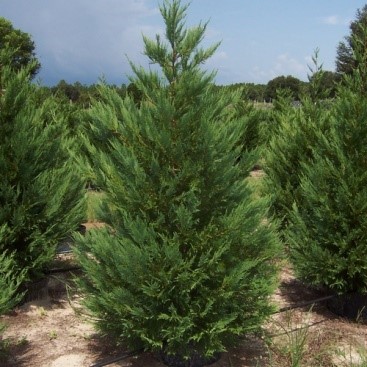Content
Leyland's cupressociparis is an evergreen coniferous plant that will become a real decoration of the garden. The tree is easy to care for and is characterized by rapid growth. Thanks to the variety of varieties, you can choose the most suitable option in terms of appearance and characteristics.
Description of Leyland's cupressociparis
Cupressopsiparis Leyland is an evergreen tree from the Conifer family. This is a hybrid plant. It was obtained as a result of natural crossing of cypress with cypress tree. Both plants belong to the same family. The authors of the resulting tree are Dutch breeders.
Leyland's Cupressopsiparis is distinguished by its height. Under favorable conditions, it grows up to 10 m. At the same time, the width of the tree reaches 2 m. Leyland's cupressociparis is characterized by rapid growth.

Every year the tree adds 50-70 cm, it has a columnar or cone-shaped shape
A large number of branches extend to the sides from a large trunk. The shoots are colored light gray and have a rough surface. The branches grow rapidly. The shoots thickly cover the tree and begin to grow from the very bottom. The branches of Leyland's cupressociparis are covered with small leaves that are very similar to needles. They are tightly connected to each other and securely attached to the shoots. The needles are scaly and painted a rich green color. When rubbed, it emits a pleasant smell.
Kupressosipris Leyland has a dense and symmetrical crown. At the beginning of the season, medium-sized cones are formed on the shoots. Their thickness is about 2 cm. In the same year, approximately five seeds ripen in each. In autumn, buds begin to form on the branches. Flowering is long lasting. It falls between March and the end of May. The flowers are small and inconspicuous, have a light shade.

Leyland's cupressociparis reaches its greatest decorative value in the spring during the flowering period
Varieties of Cupressociparis Leyland
There are different varieties of Cupressociparis Leyland. They are all characterized by good decorative qualities. However, they have slight differences.
Cupressocyparis Gold Rider
Cupressociparis Gold Raider is a massive tree reaching a height of 11 m. The diameter of the dense crown can reach up to 5 m. The tree has a columnar shape and a fairly symmetrical crown. The needles are colored green, and by autumn they acquire a faint amber tint.The lifespan of the plant is more than 60 years.

The tree produces abundant growth during the first 10 years of cultivation.
Cupressocyparis Gold River
Gold River is a compact, spherical tree. It is growing slowly. Over 10 years the growth is about 40 cm in height. The crown diameter varies within 2 m. Long flexible branches are densely covered with needles that fit tightly to each other. The crown has a pyramidal or cone-shaped shape. It is painted in a greenish-yellow color with a sun-bleached effect.

To preserve the decorative effect, it is necessary to trim the crown in a timely manner to give it the desired shape.
Kupressosociparis Castlewellan
The Castlewellan variety is a large pyramidal tree. Its height reaches 12 m, the crown width varies within 4 m. For an aesthetic appearance, it is recommended to trim the tree periodically. In the spring, the needles are painted bright green; by autumn they acquire a golden hue. Fruits are divided into female and male. The first ones are round in shape and colored brown. Male fruits are ovoid, yellowish in color.

This variety was obtained as a result of the work of Irish breeders
Cupressocyparis Blue Jeans
The Blue Jeans variety is a tall tree with a dense crown of regular shape. The long needles are colored in a rich green shade. Over the course of a year, the width of the tree increases by an average of 30 cm. This variety is characterized by good adaptability to different climatic conditions. It tolerates temporary droughts and slight drops in temperature well.

Leaves maintain vibrant color throughout the season
Cupressociparis Leylanda Pyramidalis
It is a tall tree with a columnar or conical shape. The crown is dense and symmetrical. It is painted in a rich green color. The height of the tree reaches 9 m, the width varies within 3 m. This variety belongs to the fast-growing varieties. Every year the tree grows about 40 cm in height and 20 cm in width. To make it more decorative, the crown can be trimmed.

The round cones of Pyramidalis are about the size of a pea.
Cupressocioparis Variegata
Variegata is a medium-sized variety. The crown has a conical shape. The tree is abundantly covered with flexible branches that begin to grow near the ground. The leaves are colored in a rich green shade. Immediately after flowering, fruits begin to form on the branches. These are small dark bumps, about the size of a pea.

The annual growth of the tree is about 40 cm
Kupressociparis Tweeduisenden
It is a tall and massive tree with a cone-shaped shape. The dense crown of Tweeduizendeen consists of long shoots, abundantly covered with needles. It is painted in a dark green shade. After flowering ends, small cones form. Their width is about 2 cm. Each contains five seeds. The annual growth of the tree is about 60-70 cm.

The variety has good resistance to low temperatures
Cupressocyparis Green Rocket
The variety (Green Rocket) is a compact plant, the height of which varies within 3 m. The tree has a dense crown consisting of long flexible shoots. The branches are covered with green needles that fit tightly to each other. The tree adapts well to different climatic conditions and tolerates temporary drought well.For greater decorativeness, the crown can be trimmed.

The variety is excellent for use in hedges
Features of cultivation
Leyland's cupressioparis adapts well to different conditions. However, it will grow best in regions with warm and moderately humid climates. The tree is not suitable for planting in the Urals and Siberian areas due to poor frost resistance. However, cupressociparis L can survive slight drops in temperature without harm.
For planting, you should choose well-lit places. Growing in areas with weak shade is allowed. It is important that there is no groundwater nearby. In this case, the root system will suffer. Which will lead to rotting and death of the tree. Seedlings can be planted both in open areas and in lowlands.

Group plantings will help protect the area from the wind
Leyland's cupressioparis does not have any special requirements for soil composition. However, it is best to choose places with fertile and well-moistened soil. Under no circumstances should the plant be planted in carbonate soil.
The process of planting seedlings of Leyland's cupressociparis consists of the following steps:
- Dig up the place. Apply organic or mineral fertilizer. Dig a hole. The size of the hole should be 60x70 cm.
- Place the seedling in the center of the hole and straighten the root.
- Sprinkle with soil and compact well. Form a trunk circle. Moisten the planting with plenty of warm water.
It is necessary to buy seedlings in special nurseries. They need to be carefully inspected before purchasing. They should not have mechanical damage, roughness, or creases.It is necessary that the root is well developed. There should be many lateral layers on it.
After planting, it is recommended to tie up the young seedling. To do this, you need to drive pegs on both sides at a distance of 50 cm from the tree. Tie a seedling to them, which will provide additional support and help it grow evenly.
Caring for Leyland's cupressociparis consists of timely watering. Trees need to be moistened as the top layer of soil dries out. Under normal conditions, twice every seven days. During dry periods, the amount of watering should be increased and reduced in rainy weather. If desired, you can mulch the tree trunk circle. In this case, moisture will remain in the soil longer, and the tree will have to be watered less often.
For growth, it is recommended to fertilize. Complex fertilizers are best suited for these purposes. Once a season, you can use any organic fertilizer. The tree responds well to pruning. During the season, you can trim Leyland's cupressociparis 2-3 times.
The plant does not tolerate severe frosts. Young trees must be insulated for the winter. To do this, in the autumn, you should water and mulch the tree trunk abundantly. After this, you need to additionally cover it with spruce branches or agrofibre. After warming, the shelter must be removed.
Diseases and pests
Leyland's cupressioparis is characterized by good immunity to various diseases and pests. However, it can still be attacked by insects.

The most dangerous are spider mites and woodworms; only synthetic drugs are effective in combating them (Aktara)
You can tell that a tree has been attacked by pests by the small holes that appear on the trunk and shoots.They are made by larvae for movement. In addition, a symptom of damage is that the tree suddenly stops growing. To combat larvae, you can use both acaricides and special insecticides, which are available in stick format.
Reproduction
Leyland's cupressociparis can be propagated by two methods: cuttings and root layering. In the autumn, it is necessary to cut off several healthy branches without any damage. They must have apical buds. The cuttings should be cut about 10 cm long. They should be planted in containers and stored in a cool room for the winter. The first roots will form in about 14 weeks. In spring, the cuttings need to be transplanted into open ground.

It is impossible to grow a healthy plant from self-collected seeds.
Application in landscape design
Leyland's cupressociparis has a wide range of applications in landscape design. It can be used for both single and group plantings. This is an excellent choice for creating a hedge.

It looks good both in the center of the site and in its distant parts
Low varieties are suitable for forming topiary. A good solution would be to combine several varieties of Leyland's cupressociparis. The tree tolerates pruning well. Therefore, from it you can get any green figure or hedge that has regular geometric lines.

Thanks to its thick and dense crown, kupresssotsiparis will not only decorate the area, but also protect the area from prying eyes and gusts of wind.
Conclusion
Leyland's cupressociparis is an unusual evergreen plant that has a wide range of applications in landscape design.It has good immunity and resistance to adverse weather conditions. Suitable for growing in all regions with warm and temperate climates; when young, shelter for the winter is required.
Reviews of Leyland's cupressociparis











